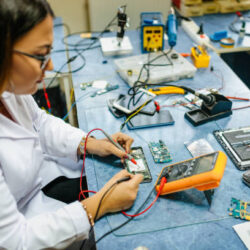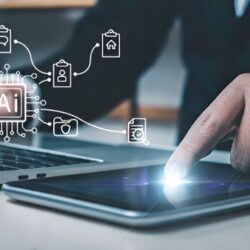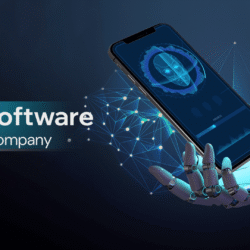Introduction
Artificial intelligence continues to redefine how technology supports modern businesses. The relationship between AI and IT Services is particularly significant, as automation and predictive intelligence reshape how organizations manage operations, secure systems, and deliver digital value.
By 2026, AI will no longer serve as an additional tool but as the foundation of how IT infrastructure operates. Enterprises will depend on it to analyze data, predict failures, manage resources, and even communicate with users through intelligent interfaces. This transformation signals a new stage in IT evolution, where technology becomes increasingly autonomous, proactive, and strategic.
As organizations explore the best IT services to support their digital transformation goals, they will look for systems that combine human expertise with machine intelligence. The partnership between data, automation, and analytics will define how the IT industry functions in the years ahead.
The Shift Toward Intelligent IT Operations
In 2026, AI will power nearly every aspect of IT management. From system monitoring to user support, intelligent frameworks will replace manual procedures with self-learning automation. AI-driven systems can identify patterns across massive data networks and respond faster than any traditional process.
This means that IT departments will move away from routine operations and toward strategic analysis and decision-making. Predictive maintenance, automated updates, and real-time alerts will prevent system issues before they disrupt business operations.
For IT service providers, this shift marks a major change in how services are delivered. Instead of troubleshooting problems, providers will focus on designing adaptive infrastructures that evolve with user needs.
AI and Predictive Infrastructure
Predictive infrastructure will be one of the most transformative aspects of AI-powered IT. It involves using algorithms and analytics to anticipate demand, detect anomalies, and manage performance in real time.
AI-based systems will continuously collect and evaluate data to identify potential points of failure. Through predictive modeling, servers and applications will be automatically optimized, ensuring that performance remains stable even under heavy usage.
This evolution benefits both companies and clients by minimizing downtime, improving reliability, and reducing operational costs. Predictive IT frameworks will set a new benchmark for efficiency across industries, particularly in high-demand sectors like finance, logistics, and healthcare.
Cloud Intelligence and Smart Deployment
As cloud computing continues to expand, AI will play a critical role in how digital environments are managed and deployed. Cloud-based IT systems will rely on AI to allocate computing resources intelligently and balance workloads based on usage patterns.
These systems will be able to:
- Predict future storage and network requirements
- Optimize cloud expenses based on historical trends
- Automate scaling without human intervention
- Ensure compliance and data security through continuous learning
This integration of AI with cloud ecosystems will make digital operations faster, smarter, and more sustainable. By 2026, cloud intelligence will not be an option but a necessity for organizations aiming to stay competitive.
Security Reinvented Through AI
Cybersecurity remains a top priority across the digital landscape. With the rise of interconnected devices and expanding data networks, traditional security measures struggle to detect modern threats.
AI introduces a smarter approach to protection. Using real-time analytics and behavioral learning, AI tools will detect irregular activities across networks before they escalate into major security incidents.
AI-driven systems will analyze millions of events per second to identify malicious activity, reducing response times and improving overall safety. For IT service providers, integrating AI into cybersecurity will be essential to meet growing client demands for data protection and compliance.
This approach not only enhances security but also builds trust among clients who rely on IT services to safeguard their information assets.
Personalized and Adaptive IT Solutions
In 2026, personalization will become an integral part of IT services. Organizations will expect their infrastructure to adjust automatically to user behavior and operational demands.
AI systems will help achieve this through adaptive frameworks capable of adjusting configurations in real time. As workloads change, resources such as processing power, memory, and storage will be balanced automatically.
This approach enables businesses to maintain performance efficiency while reducing unnecessary resource consumption. Personalized IT solutions will ensure that each enterprise operates with systems tailored to its exact requirements, improving agility and productivity.
AI’s Role in Data Management and Compliance
Data is the foundation of modern IT operations, and AI will play an increasingly important role in how that data is managed, classified, and secured. Machine learning tools can sort and analyze enormous datasets with precision, providing faster insights while ensuring compliance with data protection laws.
In industries such as healthcare, finance, and retail, regulatory frameworks are becoming more complex. AI will assist IT teams in maintaining compliance by monitoring data usage, flagging potential violations, and generating reports automatically.
By automating data governance, IT services will become more consistent and transparent. This will be a defining feature of AI-driven IT environments in 2026 and beyond.
Automation of Support Systems
Customer and internal support will also experience a major upgrade through AI. Intelligent service desks and automated workflows will reduce response times and eliminate repetitive tasks.
By analyzing query history and context, AI-driven systems will provide accurate solutions instantly. They will continuously learn from user feedback, improving the quality and accuracy of support with every interaction.
In this area, AI chatbot development will become a vital function within IT frameworks. Chatbots will handle common requests, troubleshoot technical issues, and even escalate complex cases to human experts when necessary. This balance between automation and human intervention will make service delivery more efficient and user-friendly.
AI and Sustainable IT Practices
Sustainability is gaining importance in every industry, and IT operations are no exception. AI will help reduce energy consumption and carbon emissions across data centers by monitoring usage and identifying inefficiencies.
Intelligent algorithms can adjust cooling systems, manage workloads, and predict energy needs accurately. This not only lowers costs but also supports global efforts toward greener technology.
By combining sustainability with automation, AI ensures that innovation moves forward responsibly. IT service providers that embrace these methods will set a new standard for environmental responsibility in technology.
Human-AI Collaboration in IT Environments
Contrary to early fears, AI will not replace human expertise in IT services; it will complement it. Professionals will still be central to innovation and strategy, while AI will handle repetitive and analytical functions.
This collaboration will redefine job roles within the IT sector. Engineers, analysts, and managers will work alongside intelligent tools that assist in planning, optimization, and forecasting.
Training programs and skill development initiatives will become critical to preparing the workforce for this AI-augmented future. Teams that learn to integrate technology effectively will deliver better outcomes and faster innovation.
Preparing for the AI-Driven IT Future
Organizations planning their technology roadmaps must begin adapting to AI integration now. Building AI-ready infrastructure, retraining employees, and selecting experienced IT service providers will be crucial for long-term success.
Key steps include:
- Developing scalable infrastructure compatible with AI tools
- Implementing predictive monitoring systems
- Integrating cybersecurity AI frameworks
- Aligning business goals with technological innovation
By preparing early, enterprises will be ready to harness the full potential of AI in IT services as the digital landscape continues to evolve through 2026.
What the Future Holds
Artificial intelligence will redefine how IT systems are built, maintained, and optimized. From predictive analytics to self-healing networks, automation will make technology more adaptive than ever before.
By blending AI innovation with human insight, organizations will achieve greater efficiency and stronger resilience. IT services will evolve into ecosystems that think, learn, and improve continuously.
The year 2026 marks not just another phase of technological advancement but a new era in how businesses use intelligence to achieve stability and growth. The combination of machine learning, automation, and human creativity will determine the direction of IT for the next decade.





